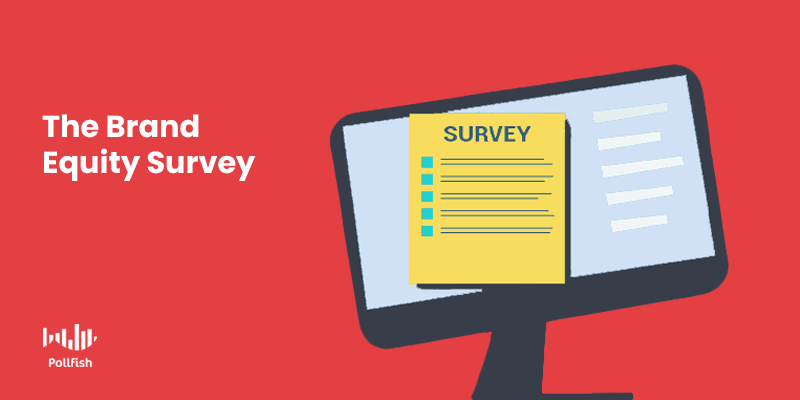Diving Into the Brand Equity Survey for Branding and Building Loyalty

The brand equity survey is a kind of survey that helps brands make sense of a difficult marketing concept to quantify, that of brand equity. Despite its murky identification, it is crucial for business success.
This marketing concept hinges on the sway a brand has over its market — not just its target market, but all the consumers in a particular market. As such, this concept alludes to the influence a brand has, particularly the kind that elevates its status and yields success.
While not all brands can be leaders in their space, they should all strive to achieve some degree of brand equity, as 59% of consumer prefer to buy from familiar brands, even in the case of purchasing new products.
This article explains brand equity, how to measure it, achieve it and how a brand equity survey can be of great use.
Defining Brand Equity
Brand equity is a marketing term that describes the value that a brand produces from having a recognizable name, anchored in the idea that well-known and reputable brands garner greater success.
Brand equity refers to recognizability — and all that it encompasses, such as the volume of sway a brand carries in the minds of its target market and all consumers making up a particular market.

The notion of brand equity renders the value of a brand, specifically the perceived value a brand has, one that makes consumers favor it over that of another. As such, brand equity is also used to contrast brands with a positive brand equity against those that produce generic name products.
Although this term is intangible, it is the driver of the financial success of companies, as it derives more than just recognition for a brand, but rather an additional layer of value due to a renowned name.
The Importance of Brand Equity
Brand equity carries a great deal of weight in the success of a company. To piggyback off of the section above, the following explains why brand equity is of chief importance for a brand, despite being intangible and difficult to fully identify within a brand.
Brand equity is important because it is far more than just a good product, service or experience. It is the added value of having a well-known name, particularly, one with a good reputation.
When a brand has positive brand equity, it easily distinguishes itself from generic name products and services. The marketing importance of this is evidently clear, given that brands should always attempt to theirs apart from others.
But there’s an even greater benefit from achieving brand equity: brands with brand equity can charge more for their products and services than can the generic products or other competitors.
Customers willingly pay more for higher-priced products if they are from a brand with positive brand equity. This benefit alone justifies the need for brand equity, as many customers base their purchases on reducing their pain of paying. This concept dictates that consumers prefer to pay less, especially when offered the same types of products.
When a brand can liberally charge more, given that customers will prefer it over brands with little to no brand equity, sales figures also increase. Thus, it builds higher profits along with more sales.
A higher degree of brand equity also yields higher influence for a company. This can lead to more viable partnerships, as big-name companies would much rather work with other well-renowned brands and have the monetary means to do so.
A rather unexpected benefit of high brand equity is the ability to recruit talent much more easily, as a brand’s recognition plays a major role in how job seekers assess a possible near-future job. Aside from the trust that brand equity builds from its familiarity, it also affects the pride of the people that associate with it — the job seekers, in this case.
When a brand has high brand equity, job seekers will naturally want to associate with it, thereby gravitating towards working at such a brand over another.
In short, brand equity is the key objective of branding market research and general branding efforts.
It is also a key goal for marketing as a goal. Although the highest achievement of marketing is achieving customer loyalty and retention, brand equity is a key factor in this objective as well. This is because brand equity, as aforesaid incites consumers to gravitate towards a particular brand, a key pillar of maintaining customer loyalty.
Defining the Brand Equity Survey
The brand equity survey is the primary source of measuring brand equity. While this concept may appear to be abstract and impossible to quantify, using this type of survey helps brings things into focus.
Largely a quantitative survey, the brand equity survey allows you to measure the key sentiment your target market has in relation to understanding your brand.
It allows market researchers to discover the degree of their own brand equity in a direct way. It also helps them better understand their competitors, particularly those that exceed them in brand equity.
A brand equity survey can be used alongside a brand awareness survey, as the latter measures awareness, one of the two major pillars of brand equity. On the contrary, brand equity also measures another key aspect — thus, its survey follows suit.

Additionally, aside from asking respondents whether they’re familiar with a brand and the degree of their familiarity, a brand equity survey inquires respondents what they think and feel about a brand.
Before creating a brand equity survey, you should understand its foundation, along with the two pillars that make it up.
The Two Pillars of Brand Equity
Although a seemingly amendable characteristic, given that multiple factors can create a positive brand equity, it is largely composed of two pillars. Fulfilling the needs of these pillars will also help with other concepts of marketing, those that will shape a brand to be its finest.
The two major pillars of brand equity are as follows:
Brand Awareness:
Brand awareness is a concept defined by how well customers can correctly identify a brand and its offerings. In order to solidify brand awareness, it needs to have a set of messaging and images unique to your brand, something that makes customers easily conjure up your brand when they see it.
For imaging that resonates, consider the golden arches of McDonald’s or the checkmark of Nike. These clearly summon these to major brands to mind. Or, for messaging, consider the slogans that have helped brands with high equity, such Goldfish, with “the snack that smiles back.”
As for long-form content (blogs, website resources) and the wording you use in advertisements, think of the kinds of ideas and values you want your target market to associate with your brand.
Your marketing efforts should infuse those ideas and values, so that customers can think of your brand upon seeing them, even if they are not part of your marketing campaigns.
Customer Experience:
Customer experience denotes the combination of all the feelings customers form of a brand throughout their interactions with it, from their awareness stage, to speaking with representatives, to browsing a website, making a purchase and beyond.
Since brands are no longer competing on their products alone, experience plays a major role in their overall view of a brand. Satisfying experiences will bring customers back to a particular brand, while poor experiences will create negative connotations with your brand, thus soiling its brand equity.
How to Achieve a Positive Brand Equity
In order to achieve brand equity, a company must first differentiate itself to establish recognition. If it is indistinguishable, there is nothing that will justify customers’ recognition of it on different occasions in their customer journey.
Thus, your brand won’t be forgettable. As this ties into the tenet of brand awareness, brands ought to consider ramping up their advertising and marketing efforts, as these will help spread the word of a brand.
As far as the customer experience tenet goes, companies can improve on this front by creating remarkable experiences that attract customers to their brand, thus securing it within their minds.
This will help them recall a brand even when they deal with other brands, serving as a critical point of comparison, in that, although the customers may be interacting with another brand, if the experience is lackluster, it will appear as the opposite of yours, which was positive.
Thus, when an experience has left a positive impression on your customers’ minds, they will associate such experiences with your brand, even when they are exposed to others.
Companies can also create brand equity for their products by making the products themselves memorable, easy to recognize and of superior quality, one that can be proven when compared with competitors’ offerings.
How to Create a Brand Equity Survey
To create a brand equity survey, use an online survey tool to screen your target market so that only qualified respondents can take place in your survey. Then, create a questionnaire with the appropriate questions for the topic of brand equity.
These should allow you to clearly evaluate your brand on the basis of its awareness and customer experience. There are four crucial ways to set up your questions:
- Unaided awareness
- Question example: “Name the first two or three electronics brands that come to mind when you think of microwaves.”
- Open-ended slots question
- Did the respondents list your brand? If so, what percentage? If not, you ought to amp up your marketing efforts.
- Question example: “Name the first two or three electronics brands that come to mind when you think of microwaves.”
- Aided awareness
- Question example: “Which of the following electronics brands have you heard from?”
- Multiple-selection answers
- Question example: “Which of the following electronics brands have you heard from?”
- Word Associations
- Question example: “What words or ideas come to mind when you see our line of electronics?
- Open-ended question
- Multiple choice question with multiple selections
- Question example: “What words or ideas come to mind when you see our line of electronics?
- Views/ Opinions
- Question example: “Based on your phone call with our rep, rate your experience form 1 to 10.”
- Ranking scale question
- Question example: “Based on your phone call with our rep, rate your experience form 1 to 10.”
Continuously Measuring and Achieving Brand Equity
Brand equity surveys not only measure their namesake concept, but they do so on a continuous basis. When you send such surveys at regular intervals, you’ll be able to monitor how your other marketing efforts have affected your brand equity.
The same idea goes for achieving a positive brand equity. There is no stronger method to test whether you’re making any progress than through a survey. What’s more is that there are other surveys that can complement this effort.
The closest such survey is the brand tracking survey, which measures your brand’s health and the effects of your brand-building campaigns. There are also other surveys you can implement into your brand equity campaigns, such as those that deal with the other critical concept making up brand equity, that of customer experience.
You can use other similar concepts, such as user testing, general branding surveys and more. The key to gaining value from these surveys is by way of a strong online survey platform, one that can streamline the entire market research process.
Pollfish Marketing Team
Ready to Try Pollfish?
Create your survey with AI, target high-quality respondents starting at $0.95 per complete, and start getting results in just minutes in real-time. From running a simple product concept survey to managing a constant stream of trackers for dozens of clients in dozens of countries, we’ve got you.
